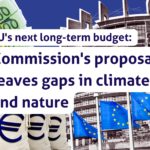
The chemical industry is one of the central energy-intensive industries (EIIs) to be targeted in EU efforts to reduce environmental and social impacts through the European Green Deal. As a dynamic and heterogeneous sector, it features considerable potential to help address climate-related and wider environmental and social crises. Opportunities to transform the industry to reduce its negative impacts are significant and this transformation must go beyond pure decarbonisation to make it a pollution and toxic-free, net zero emission, circular, and socially just industry.
The sector’s transformation needs are various, not least because of its extreme dependency on fossil fuels and its unsustainable product profiles – whether as pesticides, chemicals or plastics, many of its products are problematic. The transformation that began with a sea-change revolution in chemicals management legislation is complex and explains why the EU has published a Chemicals Strategy for Sustainability while also introducing a chemicals chapter to an EIIs transition pathway process to be published in late 2022. Instead of addressing key negative impacts at the heart of its business activities – especially its fossil fuel dependency for both energy and feedstock, its pollution profile and the hazardousness of most of its products – the sector continues to resist profound structural changes needed to achieve its transformation.
For the chemicals industry to truly contribute to wider efforts to step back from several environmental and social brinks – from climate and habitat destruction, to pollution and impacts on human and non-human health – a transformation pathway is needed. The issues to address are systemic and horizontal in relation to the different policies involved and the sector’s creativity and dynamism must be harnessed to:
➢ Phase-out hazardous chemicals and their export
➢ Reduce material and energy use
➢ Design plastic for clean circularity and reduce plastic production
➢ Improve product design to extend its lifetime
➢ Mainstream circular business models in the chemical industry
Policy priorities:
● Transformation plan: Several legislative and non-legislative processes set out roadmaps, plans or pathways for the sector, industrial ecosystem, company or installation. For the sake of effectiveness, ideally one tool taking an integrated approach to transformation will act as the reference for all policies requiring industry to develop (with societal scrutiny and acceptance) and publish its transformation actions and targets, and monitor, evaluate and report publicly upon performance at regular intervals.
● Funding the transformation: A healthy balance between private investment and public funding must be ensured, with private investment representing the larger share of total funds received. Public funding should be conditional upon acceptance of the transformation plan, and its public reporting.
● Ecodesign of products and processes: The Ecodesign of Sustainable Products Regulation (ESPR) and the Industrial Emissions Directive (IED) are tools that could help complete an industrial policy toolbox that remains weak. The landmark Fit for 55 package addressed industry weakly only through the market mechanisms of the EU ETS and the carbon border adjustment mechanism (CBAM). Alongside corporate responsibility legislation, the ESPR and IED need to strengthen requirements on chemicals and plastics in products and take an integrated approach to pollution prevention including greenhouse gas emissions, materials and circularity.
● Chemicals management: REACH revision must not be delayed and must align this chemicals management tool with other tools mentioned above, integrating climate, resources and circularity aspects in data provision while allowing for general risk assessment and strengthening precautionary approaches to ongoing health challenges such as endocrine disruption, mobility and persistence.
Our briefing provides recommendations and directions to develop an effective, integrated chemical industry transformation. These are necessary to contribute to the achievement of the objectives of the European Green Deal (EGD) underpinned by the 8th Environment Action Programme (EAP) where a toxic-free environment, the protection of the citizen’s health, reducing both climate and environmental pressures related to production processes and accelerating the transition to a circular economy are identified as priorities.
Read and download our recommendations in full here



